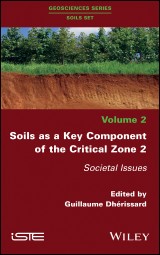Details

Soils as a Key Component of the Critical Zone 2
Societal Issues1. Aufl.
|
139,99 € |
|
| Verlag: | Wiley |
| Format: | |
| Veröffentl.: | 21.08.2018 |
| ISBN/EAN: | 9781119550938 |
| Sprache: | englisch |
| Anzahl Seiten: | 176 |
DRM-geschütztes eBook, Sie benötigen z.B. Adobe Digital Editions und eine Adobe ID zum Lesen.
Beschreibungen
<p>This volume comprises three parts: 1) from local to global, 2) what type of sustainable management? 3) territorial approaches. The first chapter demonstrates, from the French example, that better soil management is a societal issue. At the global level, the second chapter raises the question of land grabbing and land use conflicts. This book also raises the question of the legal status of the soil. It then shows how soils need to be integrated when defining sustainable agricultural systems. French and European examples illustrate how taking environmental problems into account depends as much on their acuity as on how problems are perceived by public and private, social or economic actors. Therefore, it is important to promote co-diagnosis involving the scientific community and the various other actors in order to improve the regulation on soils. This multi-actor soil governance is facilitated by the use of simple soil quality indicators. Finally, examples in France and Vietnam show how soils are to be considered as territorial commons within landscapes. This last chapter recommends in particular to put an end to the absolute right of soil ownership and to distribute the usufruct of land between various private and public beneficiaries.</p>
<p>Foreword ix</p> <p><i>André MARIOTTI</i></p> <p><b>Part 1. Local and Global 1</b></p> <p><b>Chapter 1. Effective Management of Agricultural Soils: A Challenge for Society 3<br /></b><i>Cécile CLAVEIROLE and Agnès COURTOUX</i></p> <p>1.1. Introduction 3</p> <p>1.2. Findings and issues 4</p> <p>1.2.1. Ecosystem services created by the soil 4</p> <p>1.2.2. The current major issues 5</p> <p>1.3. Recommendations of the French Economic, Social and Environmental Council 6</p> <p>1.3.1. Developing soil knowledge tools 7</p> <p>1.3.2. Protecting the land and using land planning as a preservation tool 8</p> <p>1.3.3. Supporting agricultural practices that promote good soil biological quality 9</p> <p>1.3.4. Raising awareness about soil-related issues 11</p> <p>1.4. Conclusion 12</p> <p>1.5. Bibliography 12</p> <p><b>Chapter 2. A New “Great Game” over the World’s Arable Land? 13 <br /></b><i>Alain KARSENTY</i></p> <p>2.1. Introduction 13</p> <p>2.2. The dynamic compound that is “land grabbing” 15</p> <p>2.2.1. The powers behind the phenomenon 15</p> <p>2.2.2. Quantitative estimates revised downward 16</p> <p>2.2.3. A predominance of food production partly due to oil palm 18</p> <p>2.2.4. Host countries and the origin of investors 19</p> <p>2.2.5. The nature of investors 21</p> <p>2.2.6. Land-use changes 22</p> <p>2.2.7. The consequences for agricultural structures 24</p> <p>2.3. Does the grabbing model have a future? 26</p> <p>2.3.1. Local resistance pushes for proposals for contract farming 26</p> <p>2.3.2. Possible mutual gains? 28</p> <p>2.3.3. Multilateral efforts to introduce a soft law 30</p> <p>2.3.4. The role of public policies 31</p> <p>2.4. Conclusion 32</p> <p>2.5. Bibliography 34</p> <p><b>Part 2. Different Forms of Sustainable Management 39</b></p> <p><b>Chapter 3. The Soil: A Strange Legal Notion 41<br /></b><i>Maylis DESROUSSEAUX</i></p> <p>3.1. Introduction 41</p> <p>3.2. The potential of law in the regulation of soil usage 44</p> <p>3.2.1. The variability in the law’s understanding of soil 44</p> <p>3.2.2. The lack of ecological soil governance 47</p> <p>3.3. The necessary evolution of the legal status of soil 49</p> <p>3.3.1. The protection of soil habitats recognized by law for the recovery of biodivesity 49</p> <p>3.3.2. The acknowledgment of the soil as part of our common heritag 51</p> <p>3.4. Conclusion 53</p> <p>3.5. Bibliography 53</p> <p><b>Chapter 4. Where is Soil in the Design and Management of Sustainable Farming Systems? The View of an Agronomist 57<br /></b><i>François LAURENT</i></p> <p>4.1. Introduction 57</p> <p>4.2. The soil of the agronomist: a field of diversity 58</p> <p>4.3. Soil and fertility: relationships to revisit and the need for operational knowledge 59</p> <p>4.4. Agroecology and global issues: emerging needs 66</p> <p>4.5. Conclusion 70</p> <p>4.6. Acknowledgement 70</p> <p>4.7. Bibliography 71</p> <p><b>Part 3. Territorial Approaches 75</b></p> <p><b>Chapter 5. Common Governance of Soil Quality, Complex and Multi-player Dynamics 77<br /></b><i>Didier CHRISTIN and Guillaume DHÉRISSARD</i></p> <p>5.1. Introduction 77</p> <p>5.2. Return to some territorial experiments 78</p> <p>5.2.1. Presentation of three cases in France, the Netherlands and Belgium 79</p> <p>5.2.2. Key teachings from the viewpoint of soil governance 83</p> <p>5.3. Learning about soil management in terms of common management 84</p> <p>5.3.1. Soil management, a complex and multi-player issue 84</p> <p>5.3.2. The total quality of the soils 85</p> <p>5.3.3. Common management 87</p> <p>5.4. Conclusion 90</p> <p>5.5. Bibliography 91</p> <p><b>Chapter 6. Moving Discussions Toward Co-diagnostics: Progressive Approaches 93<br /></b><i>Christine KING</i></p> <p>6.1. Introduction 93</p> <p>6.2. Scientists’ proposals 94</p> <p>6.2.1. Clarifying, objectifying and representing the organization and soil quality 94</p> <p>6.2.2. Increasing knowledge and awareness of the processes involved and the provided ecosystem services 97</p> <p>6.2.3. Increasing trust in models and in projections 103</p> <p>6.2.4. A better policy for raising awareness and transferring knowledge 105</p> <p>6.2.5. Organizing the monitoring of scientific evidence 106</p> <p>6.2.6. Developing and conducting a proper monitoring system 108</p> <p>6.3. The science/society discussion 109</p> <p>6.3.1. More and more interactions of the subject of soil and diagnostics 109</p> <p>6.3.2. Current research and the contributions of human and social sciences 116</p> <p>6.4. Conclusion 119</p> <p>6.5. Bibliography 120</p> <p><b>Chapter 7. The Soil as Territorial Commons: The Point of View of a Landscaper 127<br /></b><i>Pierre DONADIEU</i></p> <p>7.1. Introduction 127</p> <p>7.2. Territorial and landscaped commons 128</p> <p>7.2.1. Territorial commons 129</p> <p>7.2.2. Landscaped commons 131</p> <p>7.2.3. Territorialism or landscaping? 134</p> <p>7.2.4. Conclusion 137</p> <p>7.3. Building territorial commons 137</p> <p>7.3.1. Separating the rights of soil usage 137</p> <p>7.3.2. Land use of the Morbihan Regional Nature Park: a landscape issue for local societies 138</p> <p>7.3.3. Conserving the agricultural soil of the Pays de Caux: a common cause? 140</p> <p>7.3.4. The Perfume River in Huế (Vietnam) 141</p> <p>7.4. Conclusion 144</p> <p>7.5. Bibliography 145</p> <p>List of Authors 149</p> <p>Index 151</p>

















